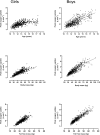Clarity and Confusion in the Development of Youth Aerobic Fitness
- PMID: 31417432
- PMCID: PMC6682696
- DOI: 10.3389/fphys.2019.00979
Clarity and Confusion in the Development of Youth Aerobic Fitness
Abstract
Peak oxygen uptake ( ) is internationally recognized as the criterion measure of youth aerobic fitness, but flawed laboratory assessments and fallacious interpretations of peak in ratio with body mass have confused our understanding of the development of aerobic fitness. Moreover, the recent emergence of specious predictions of peak from performance tests and the promotion of spurious "clinical red flags" and cardiometabolic cut-points have confused our understanding of the relationship between youth aerobic fitness and health. Recent longitudinal studies of 10-18-year-olds using multilevel allometric modeling have empirically demonstrated that peak increases in accord with sex-specific, concurrent changes in age- and maturity status-driven morphological covariates with the timing and tempo of changes specific to individuals. During both cycle ergometry and treadmill running age- and maturity status- driven changes in fat free mass have been revealed as the most powerful morphological influences on the development of youth aerobic fitness. To bring some clarity to current confusion, this paper argues that future studies must be founded on rigorous assessment and interpretation of peak and ensure that they address the development of youth aerobic fitness and its relationship with present and future health in relation to appropriate sex-specific morphological covariates governed by individual biological clocks.
Keywords: aerobic fitness; assessment; clinical red flags; fat free mass; multilevel allometric modeling; peak oxygen uptake; scaling; youth.
Figures
References
-
- Armstrong N. (2019). Development of the youth athlete. Oxford: Routledge; 145–149.
-
- Armstrong N., McManus A. M. (2017). “‘Aerobic fitness’,” in Oxford Textbook of Children’s Sport and Exercise Medicine, eds Armstrong N., van Mechelen W. (Oxford: Oxford University Press; ), 161–180.
Publication types
LinkOut - more resources
Full Text Sources


